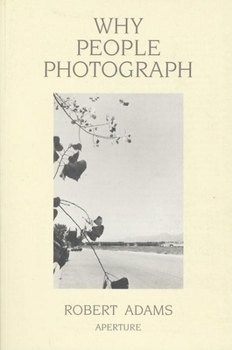Robert Adams: Why People Photograph: Selected Essays and Reviews
Select Format
Select Condition 
Book Overview
A now classic text on the art, Why People Photograph gathers a selection of essays by the great master photographer Robert Adams, tackling such diverse subjects as collectors, humor, teaching, money and dogs. Adams also writes brilliantly on Edward Weston, Paul Strand, Laura Gilpin, Judith Joy Ross, Susan Meiselas, Michael Schmidt, Ansel Adams, Dorothea Lange, and Eug?ne Atget. The book closes with two essays on "working conditions" in the...
Format:Paperback
Language:English
ISBN:0893816035
ISBN13:9780893816032
Release Date:June 2005
Publisher:Aperture
Length:189 Pages
Weight:0.70 lbs.
Dimensions:0.6" x 5.5" x 8.3"
Customer Reviews
5 ratings
In full agreement with Chris Akin
Published by Thriftbooks.com User , 16 years ago
It couldn't be better said. This book is pure enjoyment. What a wonderful command of the language from this former English professor! Insightful and reflective, this book is about so much more than the obvious. Though perhaps the title is not that far amiss... My only "criticism" would regard the desire to see more of the photographs to which Adams refers or describes in detail. He gives us very few opportunities to understand what he says by looking at the picture itself.
Title might not be accurate, but book is nonetheless terrific
Published by Thriftbooks.com User , 18 years ago
Most of the book doesn't really respond to the title, but Robert Adams writes in a very engaging manner and talks about issues that most photographers will find interesting. I found particularly interesting his discussion of famous photographers and their aesthetic philosophy. This is not a book for the casual photographer, but for the photographer who is interested in photography's background, or a collector who'd like to better understand the photographer as artist, this book is terrific.
Photographers -- this book is your friend.
Published by Thriftbooks.com User , 21 years ago
If you are not connected with any photography/art community, this book is for you. If none of your friends has an MFA, and if you are in need of someone who can speak intelligently about photography as art, then again, this book is for you. Robert Adams' writing is clear, concise, and insightful. Adams tells us why we photograph, for example, why we photograph landscapes. The answers include: because the images are of "emblems of a land" (pages 146 and 163), because our photographed subjects redefine us and is part of our biography (page 15), because art is "specifics made universal" (page 120), and because "art is a discovery of harmony" (page 181). Adams consoles photographers who come to realize that spending ten years doing photography won't necessarily result, e.g., in a contract for preparing a coffeetable book: "[t]hey may or may not make a living by photography but they are alive by it" (page 15); and the experience of having an exhibit where the photographer "stand[s] through the opening of an exhibition to which only officials have come." (page 16). Adams reveals the secrets of some of the masters, e.g., Weston: "limbs and torsos . . . treated as shapes to be enjoyed as one might the sight of a smooth stone" (page 64); and Paul Strand: "he worked off axis as if it were a moral principle . . . but usually just slightly off axis." (page 81) Robert Adams offers some critiques of the masters, e.g., of Paul Strand: "[o]ff-centering is used here . . . it begins to seem formulaic (page 87); and of Ansel Adams: "I have been derivative of myself for fifty years." (page 116). Robert Adams' book is a stand-alone book, that is, it does not require a knowledge of literature, art criticism, or history. The book is for the layperson. Another fine, insightful book on photography criticism is Light Readings by A.D. Coleman. A remarkable bit of insight by A.D. Coleman, for example, concerns his view of the typical amateur (page 164): "Typically, a snapshot of someone's relative at Grant's Tomb will show the relative too far from the camera to be identifiable and Grant's Tomb too close to be recognizable . . . Their charm and poignancy derives specifically from their failure to communicate . . ."The writings of Robert Adams and A.D. Coleman may be contrasted with the poetic commentary David Wallace (in Morley Baer's The Wilder Shore) and with the "writing" of Sally Eauclair in The New Color Photography and New Color/New Work. The writings of David Wallace and Sally Eauclaire are silly, and sometimes very silly, and serve only to draw attention to the words printed on the page instead of serving to invoke new concepts and connections in the mind.
Dog eared and well thumbed
Published by Thriftbooks.com User , 22 years ago
This book has been of great assitance to me in my teaching and creative practice over the years. It has been a source of inspiration and motivation allowing me to continue working with my cameras and photography, at the same time reconciling different ideas about 'money', 'ideas', 'freinds', 'teaching' etc to enable me to maintain my faith in what I do.The essays on teaching and money in particular have helped me clarify my position as both an artist and teacher, I highly recommend this book to anyone considering teaching or photography as a career.
Adams writes about photography as well as he photographs
Published by Thriftbooks.com User , 26 years ago
This excellent book of essays reveals much about the motivations of photographers and provides thought-provoking subjects relative to a life in photography. Adams' writing is straightforward and insightful and an excellent inspiration in a sometimes confusing, but mysterious art.





